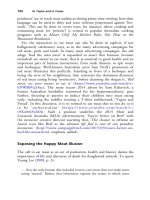The palgrave international handbook of a 229
Bạn đang xem bản rút gọn của tài liệu. Xem và tải ngay bản đầy đủ của tài liệu tại đây (26.53 KB, 1 trang )
224
J. Maher and T. Wyatt
In referring to wildlife as ‘animals’ we specifically mean ‘non-human animals’
in this context, because clearly humans are also animals.
Our discussion is informed by data taken from the Convention on the
International Trade in Endangered Species of Wild Fauna and Flora
(CITES) online trade database and also by data collected for the European
Union EFFACE project1 (Sollund and Maher 2015). The chapter begins
with an overview of the prevalence of legal and illegal wildlife trade providing
an insight into the regions of the world involved. This is followed by details
of the abuse that is endured by the wildlife in either case. We then explore
the motivations for engaging in the wildlife trade, using two criminological
theories to help explain offenders’ behaviour in the illegal trade. This is
followed by an evaluation of current responses to the illegal wildlife trade,
with a particular focus on the official UK response.
Prevalence
Due to the scale and global and complicated nature of the legal and illegal
trade, accurate data is scarce and estimates are often relied upon. Some
information is available in the form of which species of animals are
protected and in which capacity by CITES. As of October 2013 there are
5,592 species listed in the CITES appendices—630 in Appendix I, 4,827 in
Appendix II, and 135 in Appendix III (CITES 2015). The animals traded
are amphibians, birds, fish, invertebrates, mammals and reptiles. The legal
trade in CITES species is worth billions of dollars annually and includes
millions of individual animals. It is important to note that the CITES
database only records trade in protected species; many more species fall
outside the CITES remit and are thus traded legally without regulation or
measurement. (Thereby, these estimates do not include the billions of
additional dollars generated from non-regulated animal trade, such
as from non-protected fish species). The World Wildlife Fund (WWF)
(n.d.) estimates a yearly total of USD 160 billion. As indicated above,
a portion of this trade is live animals and plants. These fill the demand
by zoos, circuses and laboratories as well as for private collections, gardens,
1
The EFFACE project contained four case study locations—UK, Norway, Brazil, Columbia—where
qualitative data was collected by means of 28 semi-structured expert interviews (UK: 11, Norway: 12
and five offenders) and five observations (UK: 4, Norway 1) and documentary analysis on 46 customs
confiscation reports. Professor Ragnhild Sollund, co-researcher on the EFFACE project, compiled the
data from Norway and South America.









